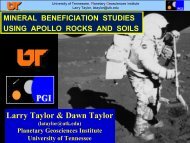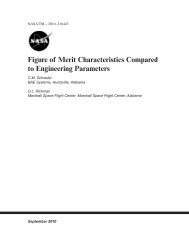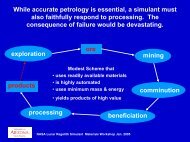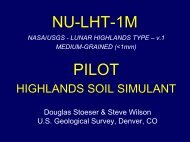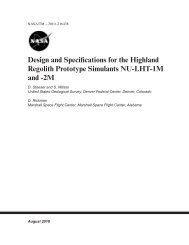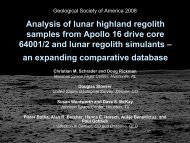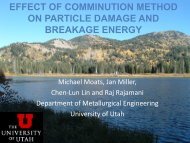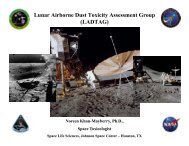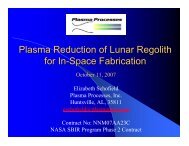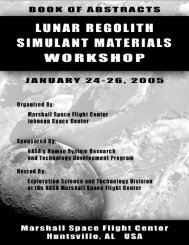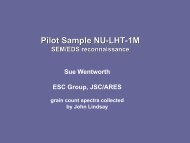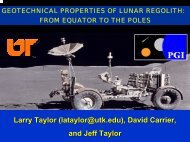Modal Analyses of NU-LHT-1M and - NASA
Modal Analyses of NU-LHT-1M and - NASA
Modal Analyses of NU-LHT-1M and - NASA
You also want an ePaper? Increase the reach of your titles
YUMPU automatically turns print PDFs into web optimized ePapers that Google loves.
PTMSS, 2008<br />
Montreal, Quebec<br />
Extant <strong>and</strong> Extinct Lunar Regolith<br />
Simulants: <strong>Modal</strong> <strong>Analyses</strong> <strong>of</strong> <strong>NU</strong>-<strong>LHT</strong>-<strong>1M</strong><br />
<strong>and</strong> -2m, OB-1, JSC-1, JSC-1A <strong>and</strong> -1AF,<br />
FJS-1, <strong>and</strong> MLS-1<br />
Christian Schrader [1]*, Doug Rickman [2], Carole Mclemore [2], John Fikes<br />
[2], Stephen Wilson [3], Doug Stoeser [3], Alan Butcher [4], Pieter Botha[ 4]<br />
[1] BAE Systems-MSFC, Huntsville AL; [2] <strong>NASA</strong>-MSFC, Huntsville AL; [3]<br />
USGS, Denver CO; [4] Intellection Ltd., Brisbane, QLD Australia
Participants<br />
<strong>NASA</strong> - Marshall Space Flight Center leads this<br />
simulant development <strong>and</strong> characterization<br />
JSC, GRC, <strong>and</strong> KSC contribute other work<br />
towards the characterization <strong>of</strong> simulant <strong>and</strong><br />
lunar materials<br />
The United States Geological Survey in<br />
Denver assists in characterization <strong>and</strong><br />
leads in the manufacturing <strong>of</strong> <strong>NU</strong>-<strong>LHT</strong><br />
series<br />
Intellection, Ltd., in Brisbane <strong>and</strong><br />
Intellection Corp., USA in<br />
Westminster CO<br />
Slide 2<br />
C.M. Schrader<br />
6/2/2008
Purpose<br />
• This work is part <strong>of</strong> a larger effort to compile an internally<br />
consistent database on lunar regolith (Apollo samples) <strong>and</strong> lunar<br />
regolith simulants.<br />
• Characterize existing lunar regolith <strong>and</strong> simulants in terms <strong>of</strong><br />
• Particle type<br />
• Particle size distribution<br />
• Particle shape distribution<br />
• Bulk density<br />
• Other compositional characteristics<br />
• Evaluate regolith simulants (Figure <strong>of</strong> Merit) by above<br />
properties by comparison to lunar regolith (Apollo sample)<br />
This presentation covers new data on lunar simulants.<br />
Slide 3<br />
C.M. Schrader<br />
6/2/2008
User’s h<strong>and</strong>book<br />
The <strong>NASA</strong>-MSFC simulant group is compiling a simulant<br />
user’s h<strong>and</strong>book with a matrix <strong>of</strong> simulant properties.<br />
This will help guide users choose a simulant for their<br />
applications.<br />
Slide 4<br />
C.M. Schrader<br />
6/2/2008
Outline<br />
1) Simulant types <strong>and</strong> specific simulants<br />
2) New work – modal data<br />
A. QEMSCAN ® instrument <strong>and</strong> approach<br />
B. Preliminary results <strong>of</strong> modal analysis <strong>of</strong> simulants<br />
i. Plagioclase<br />
ii. Pyroxene<br />
iii. Olivine<br />
iv. Glass<br />
3) Phase chemistry (mostly previous work)<br />
A. Plagioclase composition<br />
B. Glass composition<br />
4) Examples <strong>of</strong> other new results<br />
Slide 5<br />
C.M. Schrader<br />
6/2/2008
Lunar simulants -- mare <strong>and</strong><br />
highl<strong>and</strong>s<br />
JSC-1A lunar mare<br />
simulant<br />
<strong>NU</strong>-<strong>LHT</strong>-<strong>1M</strong> lunar<br />
highl<strong>and</strong>s simulant<br />
Slide 6<br />
C.M. Schrader<br />
6/2/2008
Current emphasis<br />
<strong>NASA</strong> lunar architecture places<br />
the first permanent bases near<br />
a pole, which is likely dominated<br />
by lunar highl<strong>and</strong>s-type terrain.<br />
<strong>NASA</strong>-MSFC <strong>and</strong> USGS are<br />
focusing on process control.<br />
Current prototypes are<br />
characteristic <strong>of</strong> lunar highl<strong>and</strong>s<br />
material.<br />
We plan to characterize <strong>and</strong><br />
prototype mare types in the<br />
future.<br />
Slide 7<br />
C.M. Schrader<br />
6/2/2008
Overview <strong>of</strong> lunar simulants<br />
Simulant(s)<br />
<strong>NU</strong>-<strong>LHT</strong><br />
series<br />
Type<br />
Highl<strong>and</strong>s<br />
Primary<br />
Reported Use<br />
General<br />
Manufacturer feedstock status<br />
<strong>NASA</strong>-MSFC<br />
<strong>and</strong> USGS<br />
OB-1 Highl<strong>and</strong>s Geotechnical Norcat<br />
JSC-1 (-1A,<br />
-1AF)<br />
FJS-1<br />
Mare, low-<br />
Ti<br />
Mare, low-<br />
Ti<br />
Geotechnical<br />
<strong>and</strong> lesser<br />
chemical<br />
Geotechnical<br />
Orbitec, Inc.<br />
Japanese,<br />
(JAXA,<br />
LETO)<br />
Stillwater mine<br />
(MT),<br />
commercial<br />
minerals<br />
Shawmere<br />
anorthosite,<br />
olivine slag<br />
glass<br />
Basalt ash, San<br />
Francisco<br />
volcanic field<br />
(AZ)<br />
Mt. Fuji area<br />
basalt<br />
In<br />
production<br />
<strong>and</strong> use<br />
In<br />
production<br />
<strong>and</strong> use<br />
In<br />
production<br />
<strong>and</strong> use<br />
No longer<br />
available<br />
MLS-1<br />
Mare, high-<br />
Ti<br />
Chemical<br />
University <strong>of</strong><br />
Minnesota<br />
Basalt sill,<br />
Duluth complex<br />
No longer<br />
available<br />
Slide 8<br />
C.M. Schrader<br />
6/2/2008
QEMSCAN ® instrumentation<br />
Bruker AXS X-ray<br />
detectors<br />
Carl Zeiss custom<br />
SEM<br />
QEMSCAN ® uses<br />
advanced e-beam<br />
technology from Carl<br />
Zeiss <strong>and</strong> combines<br />
this with high<br />
resolution BSE <strong>and</strong> SE<br />
imaging, <strong>and</strong> state-<strong>of</strong>the-art<br />
Energy<br />
Dispersive<br />
Spectrometers. It<br />
integrates these using<br />
iDiscover s<strong>of</strong>tware to<br />
provide a solution<br />
capable <strong>of</strong> identifying<br />
most rock-forming<br />
minerals in just<br />
milliseconds<br />
Intellection<br />
QEM*SEM®<br />
integrated control<br />
hardware<br />
Slide 9<br />
C.M. Schrader<br />
6/2/2008
QEMSCAN ® analysis<br />
Digital photograph <strong>of</strong> polished block<br />
QEMSCAN ® Backscattered Electron<br />
photo-micrographic montage <strong>of</strong> a<br />
polished block<br />
Slide 10<br />
C.M. Schrader<br />
6/2/2008
QEMSCAN ® analysis<br />
Digital photograph <strong>of</strong> a 30mm<br />
diameter polished block<br />
QEMSCAN ® false-coloured, digital<br />
particle mineral map montage <strong>of</strong> a<br />
polished block<br />
Slide 11<br />
C.M. Schrader<br />
6/2/2008
Results: QEMSCAN ® modal analysis<br />
Average <strong>of</strong> two replicate runs<br />
These modal<br />
data are total %<br />
<strong>of</strong> phase<br />
proportion<br />
regardless <strong>of</strong><br />
occurrence, e.g.,<br />
as free minerals,<br />
in a lithic<br />
fragment or<br />
agglutinate...<br />
Slide 12<br />
Minerals<br />
<strong>NU</strong>-<strong>LHT</strong>-<br />
<strong>1M</strong> OB-1 JSC-1 JSC-1A JSC-1AF FJS-1 MLS-1<br />
Plagioclase 51.87 44.35 32.47 37.83 48.47 48.78 25.45<br />
Clinopyroxene 8.95 2.95 14.67 18.77 21.15 24.39 35.86<br />
Orthopyroxene 6.76 0.19 0.65 0.66 1.62 1.37 1.37<br />
Olivine 5.79 6.27 18.29 12.44 9.22 4.94 1.06<br />
Glass 24.07 43.22 30.86 26.67 15.68 7.15 22.29<br />
Magnetite 0.15 0.07 0.02 0.01 0.00 0.04 0.45<br />
Chromite 0.11 0.01 0.01 0.00 0.00 0.01 0.00<br />
Ilmenite 0.53 0.00 0.07 0.11 0.08 3.65 12.38<br />
Sulphides 0.02 0.35 0.19 0.17 0.31 0.16 0.10<br />
Iron 0.20 0.01 0.00 0.00 0.00 0.00 0.06<br />
MgFeAl Silicate 1.13 1.83 1.76 3.06 3.09 1.53 0.82<br />
K Feldspar 0.13 0.08 0.39 0.07 0.11 7.24 0.07<br />
Quartz 0.21 0.48 0.50 0.01 0.04 0.47 0.00<br />
Calcite 0.06 0.08 0.07 0.11 0.14 0.00 0.02<br />
Others 0.04 0.12 0.07 0.07 0.08 0.27 0.08<br />
Total 100.00 100.00 100.00 100.00 100.00 100.00 100.00<br />
C.M. Schrader<br />
6/2/2008
Results: QEMSCAN ® modal analysis<br />
Average <strong>of</strong> two replicate runs<br />
Slide 13<br />
C.M. Schrader<br />
6/2/2008
Results: QEMSCAN ® modal analysis<br />
Replicate runs<br />
Slide 14<br />
C.M. Schrader<br />
6/2/2008
<strong>Modal</strong> Analysis<br />
<strong>Modal</strong> analysis measures the proportion by area% <strong>of</strong> a phase<br />
(mineral or glass) in a material. Area% is the same as volume%<br />
in a r<strong>and</strong>omly oriented material <strong>and</strong> mass% can be computed if<br />
composition is known.<br />
Physical characteristics such as hardness, fracture <strong>and</strong> cleavage<br />
behavior (which control abrasiveness, e.g.) are intrinsic<br />
characteristics <strong>of</strong> minerals <strong>and</strong> glass.<br />
Geo-mechanical behavior <strong>of</strong> a material is controlled largely by the<br />
proportions <strong>of</strong> these constituent parts, as well as by the size <strong>and</strong><br />
shape distributions <strong>of</strong> particles.<br />
<strong>Modal</strong> proportions <strong>of</strong> phases are also the first piece <strong>of</strong> information<br />
necessary in underst<strong>and</strong>ing physiochemical behavior important to<br />
melting, oxygen extraction, etc.<br />
Slide 15<br />
C.M. Schrader<br />
6/2/2008
Results: QEMSCAN ® modal analysis<br />
Average <strong>of</strong> two replicate runs<br />
Minerals<br />
Apollo<br />
16:<br />
64001/2<br />
<strong>NU</strong>-<br />
<strong>LHT</strong>-<br />
<strong>1M</strong><br />
OB-1<br />
Apollo 11<br />
&12 JSC-1 JSC-1A JSC-1AF FJS-1 MLS-1<br />
Plagioclase 43-44 51.87 44.35 11-15 32.47 37.83 48.47 48.78 25.45<br />
Clinopyroxene 0.6-0.7 8.95 2.95 14.67 18.77 21.15 24.39 35.86<br />
Orthopyroxene ~2.5 6.76 0.19 0.65 0.66 1.62 1.37 1.37<br />
Total Pyroxene ~3 15.71 3.14 25-37 15.32 19.43 22.77 25.76 37.23<br />
Olivine 0.8-0.9 5.79 6.27 2-10 18.29 12.44 9.22 4.94 1.06<br />
Glass 44-46 24.07 43.22 31-45 30.86 26.67 15.68 7.15 22.29<br />
Highl<strong>and</strong>s data are from QEMSCAN ® analysis <strong>of</strong> thin sections from<br />
64001,6031 <strong>and</strong> 64002,6019 Apollo 16 drive core.<br />
Mare data are from Taylor et al. (1996) from 10084,1618, 12030,122,<br />
<strong>and</strong> 12001,7 Apollo 11 <strong>and</strong> 12 samples <strong>of</strong> low-Ti mare samples <strong>of</strong><br />
varying maturity. Values determined by SEM EDS<br />
Slide 16<br />
C.M. Schrader<br />
6/2/2008
Other crucial phases<br />
Minerals that occur in much less abundance such than those<br />
mentioned can be very important to ISRU processes.<br />
Ilmenite (FeTiO 3 ) is an important lunar mineral for oxygen extraction<br />
by H 2 -reduction.<br />
Halogen (F, Cl)-bearing phases like apatite can have significant<br />
adverse effects on many ISRU processes. Sulfur, phosphorus,<br />
bromine <strong>and</strong> iodine bearing phases are also almost certain to be<br />
important.<br />
Data on these minerals is still being refined.<br />
Slide 17<br />
C.M. Schrader<br />
6/2/2008
Chemical composition <strong>of</strong> minerals<br />
<strong>and</strong> glass<br />
In addition to modal proportions, the chemical make-up <strong>of</strong> phases<br />
exerts a huge control over physiochemical processes such as<br />
melting <strong>and</strong> those processes necessary to oxygen extraction.<br />
Plagioclase feldspar, a major constituent <strong>of</strong> lunar regolith, is a good<br />
example.<br />
Slide 18<br />
C.M. Schrader<br />
6/2/2008
Plagioclase chemistry<br />
Another consideration is the chemical composition <strong>of</strong> the<br />
plagioclase mineral grains.<br />
Plagioclase feldspar is a solid solution mineral that varies between<br />
two end-member compositions:<br />
Anorthite - CaAl 2 Si 2 O 8<br />
<strong>and</strong><br />
Albite - NaAlSi 3 O 8<br />
⇒ The Ca/Na <strong>and</strong> Al/Si ratios vary simultaneously.<br />
Slide 19<br />
C.M. Schrader<br />
6/2/2008
Plagioclase composition<br />
Lunar Highl<strong>and</strong>s: An >90%<br />
<strong>NU</strong>-<strong>LHT</strong>-<strong>1M</strong> range: An 75-85%<br />
OB-1: Shawmere, approx. An 75%<br />
Lunar Mare: An 75-95%<br />
JSC-1: An 64-71% (Carpenter 2005)<br />
JSC-1A: An 70% (average -- Hill et al., 2007)<br />
JSC-1AF: An 70% (Carpenter, 2006)<br />
MLS-1: An 44-50% (Carpenter, 2005; Hill et al., 2007)<br />
Slide 20<br />
C.M. Schrader<br />
6/2/2008
Example - Why mineral<br />
chemistry matters<br />
An 100%<br />
melts at<br />
~1230° C<br />
Albite, An 0%,<br />
melts at ~750° C<br />
Slide 21<br />
C.M. Schrader<br />
6/2/2008
<strong>NU</strong>-<strong>LHT</strong> series glass: plasma melting<br />
<strong>NU</strong>-<strong>LHT</strong>-<strong>1M</strong> <strong>and</strong> -2M: glass is derived from melting fine-grained<br />
material (mill s<strong>and</strong>) from the Stillwater mill.<br />
Slide 22<br />
C.M. Schrader<br />
6/2/2008
Glass in lunar simulants<br />
<strong>NU</strong>-<strong>LHT</strong>-<strong>1M</strong>:<br />
OB-1:<br />
JSC-1 series:<br />
FJS-1:<br />
MLS-1:<br />
Glass is derived by plasma-melting <strong>of</strong> noritic<br />
feedstock<br />
Ca-Al-Si with moderate Fe <strong>and</strong> Mg<br />
Glass is an olivine slag<br />
Fe <strong>and</strong> Mg-rich with Si<br />
Natural basalt glass<br />
Fe-Mg-Ca-Al-Si with lesser Na<br />
Natural basalt glass<br />
no analyses available<br />
Glass is derived by plasma-melting <strong>of</strong> basaltic<br />
feedstock<br />
Fe-Mg-Ca-Al-Si with lesser Na<br />
Slide 23<br />
C.M. Schrader<br />
6/2/2008
Some simulant glass chemistry<br />
oxide <strong>NU</strong>-<strong>LHT</strong> JSC-1A JSC-1AF<br />
SiO2 46.6 46.8 46.11<br />
TiO2 0.115 2.44 2.8<br />
Al2O3 21.55 13.9 14.92<br />
FeO** 5.08 12.1 12.66<br />
MnO 0.09 0.21 0.22<br />
MgO 9.5 5.6 5.07<br />
CaO 12.6 10.5 9.98<br />
Na2O 0.965 3.89 3.96<br />
K2O 0.12 1.17 1.43<br />
P2O5 0.07 1.04 1.02<br />
Cr2O3 0.12 b.d.l. 0.01<br />
LOI 2.74 n.d. n.d.<br />
Total 99.55 97.65 98.18<br />
<strong>NU</strong>-<strong>LHT</strong> values are from<br />
an analysis <strong>of</strong> the<br />
feedstock Stillwater “mill<br />
s<strong>and</strong>” melted to form<br />
glass.<br />
JSC-1A <strong>and</strong> -1AF<br />
analyses from Hill et al.<br />
(2007) <strong>and</strong> Paul Carpenter<br />
(2005, 2006) reports <strong>and</strong><br />
presentations.<br />
**total Fe as FeO<br />
Slide 24<br />
C.M. Schrader<br />
6/2/2008
Conclusions<br />
We are compiling huge numbers <strong>of</strong> data points on lunar regolith <strong>and</strong><br />
simulants. Analysis <strong>and</strong> refinement is continuing.<br />
<strong>Modal</strong> composition is one important parameter to both geotechnical<br />
<strong>and</strong> to physiochemical behavior.<br />
For physiochemical behavior important to many ISRU purposes,<br />
phase chemistry is also very important, perhaps particularly with<br />
regards to glass chemistry.<br />
Slide 25<br />
C.M. Schrader<br />
6/2/2008
References:<br />
Heiken, G., Vaniman, D., <strong>and</strong> French, B.M., 1991, Lunar Sourcebook: A User's<br />
Guide to the Moon. Cambridge University Press, Cambridge [Engl<strong>and</strong>], New York.<br />
Hill, E., Mellin, M.J., Deane, B., Liu, Y., <strong>and</strong> Taylor, L.A., 2007, Apollo sample 70051<br />
<strong>and</strong> high <strong>and</strong> low-Ti soil simulants MLS-1A <strong>and</strong> JSC-1A: Implications for future<br />
lunar exploration, Journal <strong>of</strong> Geophysical Research, v. 112, E02006.<br />
Richard, J., Sigurdson, L., <strong>and</strong> Battle, M.M., 2007, OB-1 Lunar highl<strong>and</strong>s physical<br />
simulant: Evolution <strong>and</strong> roduction, abstract <strong>and</strong> presentation at Lunar <strong>and</strong> Dust<br />
Regolith Simulant Workshop, Huntsville, AL.<br />
Taylor, L.A., Patchen, A., Taylor, Chambers, J.G., <strong>and</strong> McKay, D.S., 1996, X-ray<br />
digital imaging petrography <strong>of</strong> lunar mare soils: <strong>Modal</strong> analyses <strong>of</strong> minerals <strong>and</strong><br />
glasses, Icarus, v. 124, pp. 500-512.<br />
Slide 26<br />
C.M. Schrader<br />
6/2/2008
<strong>NU</strong>-<strong>LHT</strong>-1: QEMSCAN ® particle<br />
analysis<br />
Plagioclase<br />
Clinopyroxene<br />
Orthopyroxene<br />
Olivine<br />
K Feldspar<br />
MgFeAl Silicate<br />
Magnetite<br />
Chromite<br />
Ilmenite<br />
Sulphides<br />
Calcite<br />
Fe Silicate (Glass)<br />
Ca Al Silicate (glass)<br />
CaMgFe Glass<br />
TiSi Glass<br />
Iron<br />
Quartz<br />
Others<br />
Slide 27<br />
C.M. Schrader<br />
C.M. Schrader<br />
6/2/2008
MLS-1: QEMSCAN ® particle analysis<br />
Plagioclase<br />
Clinopyroxene<br />
Orthopyroxene<br />
Olivine<br />
K Feldspar<br />
MgFeAl Silicate<br />
Magnetite<br />
Chromite<br />
Ilmenite<br />
Sulphides<br />
Calcite<br />
Fe Silicate (Glass)<br />
Ca Al Silicate (glass)<br />
CaMgFe Glass<br />
TiSi Glass<br />
Iron<br />
Quartz<br />
Others<br />
Slide 28<br />
C.M. Schrader<br />
6/2/2008
Results: QEMSCAN ® determined<br />
particle shape<br />
Slide 29<br />
C.M. Schrader<br />
6/2/2008
QEMSCAN® analysis<br />
Example <strong>of</strong> particles<br />
delineated by image<br />
analysis.<br />
Example <strong>of</strong> a<br />
mineral <strong>and</strong> phase<br />
list.<br />
Quartz<br />
Plagioclase (Ab-An60)<br />
Plagioclase (An60-An100)<br />
K Feldspar<br />
Clinopyroxene<br />
Orthopyroxene<br />
Olivine<br />
Mg Silicates<br />
Ca Al Silicate Glass<br />
MgFeAl Silicate<br />
CaMgFe Glass<br />
Iron<br />
Magnetite<br />
Chromite<br />
Ilmenite<br />
Mosaic images are particulated using <strong>of</strong>f-line image analysis<br />
s<strong>of</strong>tware, so that each measured particle can be examined <strong>and</strong><br />
quantified for parameters such as modal composition, texture <strong>and</strong><br />
shape.<br />
Slide 30<br />
C.M. Schrader<br />
6/2/2008



